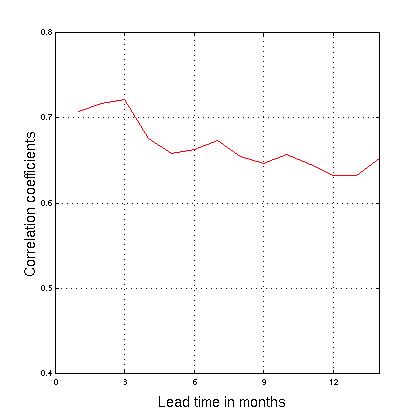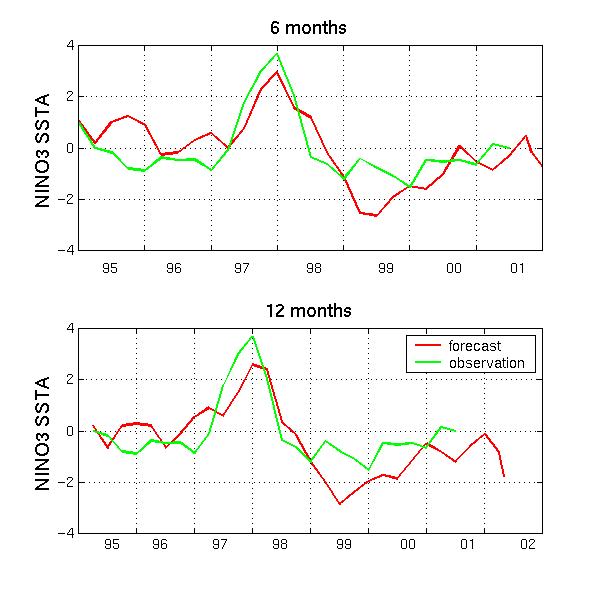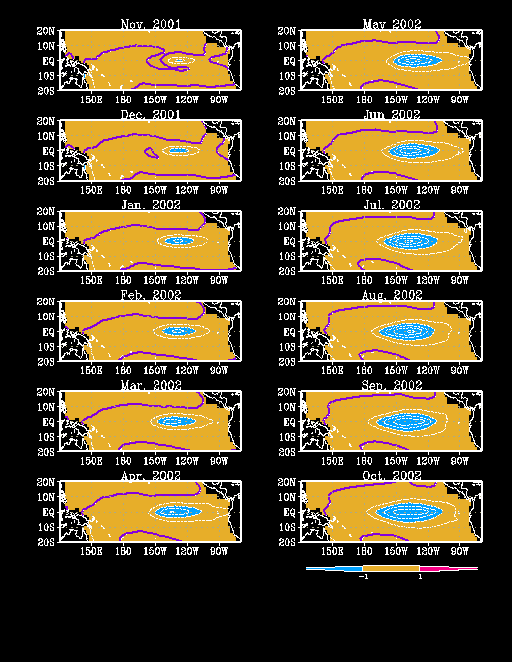Neural-dynamical hybrid coupled model forecasts of the tropical
Pacific sea surface temperatures
Youmin Tang and William Hsieh
The forecast model is the neural-dynamical hybrid coupled model used in
our previous forecasts (Tang and Hsieh
2001a), but NCEP sea level height anomaly (SLHA) data (instead of
the heat content anomaly data) are assimilated to initiate the
forecasts, as the NCEP SLHA data are updated more regularly.
Assimilating NCEP SLHA yields similar improvement to forecast skills as
assimilating heat content anomalies (Tang and Hsieh 2001b). Fig. 1 shows
the correlation skills of the predicted sea surface temperature
anomalies (SSTA) in the NINO3 region in the equatorial eastern Pacific
during 1990-1999 using our model with SLHA assimilation. The predictions
were made at three months intervals (starting on 1 January, 1 April, 1
July and 1 October) and continued until a lead time of 15
months.
Fig.1 Correlation skills of predicted NINO3 SSTA

Fig. 2 shows the prediction of the NINO3 SSTA starting from 1994 to
2001 at lead times of 6 months and 12
months.
Fig.2 Observed and predicted NINO3 SSTA at lead times of 6 and 12 months

Fig 3 shows our latest forecasts (initialized using data till the end of
July, 2001), indicating that the slightly cool conditions in the
equatorial Pacific during
winter, 2001 will intensify by spring,
2002, turning into a La Nina by summer, 2002.
Fig.3 Predicted SSTA of the tropical Pacific
Contour intervals are 0.5 degree Celsius, with positive anomalies
indicated by solid contours, negative anomalies by dashed contours, and
zero by thick contours. Positive anomalies above 1
degree are shaded in red, negative anomalies below -1 degree are in
blue, and the zero contour is in purple.

References:
Tang, Y. and W.W. Hsieh, 2001a: Neural-dynamical hybrid coupled model forecasts of the tropical
Pacific sea surface temperatures. Experimental Long-Lead Forecast Bulletin, 10(1):1-4.
Tang, Y. and W. W. Hsieh, 2001b: Impact of data assimilation on
ENSO simulations and predictions in
a hybrid coupled model framework. J. of Climate (submitted).
[http://www.ocgy.ubc.ca/~tym/papers.html]
Back to [UBC Climate Prediction Group Home
Page]



